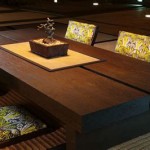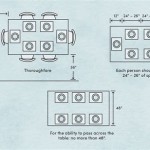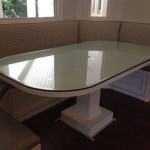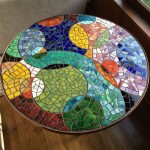Dining Room Table Centerpiece Decorating Ideas
The dining room table serves as a focal point for meals, gatherings, and sometimes even workspaces. A well-chosen centerpiece can elevate the ambiance of the entire room, reflecting personal style and complementing the overall decor. Selecting the right centerpiece requires consideration of factors such as table size, room aesthetic, and the intended purpose of the space. Furthermore, seasonal variations and personal preferences play a crucial role in creating a visually appealing and functional arrangement.
Understanding Table Size and Shape
The dimensions of the dining room table are paramount when selecting a centerpiece. A large, ornate table can accommodate a more substantial and elaborate arrangement, while a smaller, more minimalist table benefits from a simpler, less overwhelming design. A general guideline is to ensure that the centerpiece occupies approximately one-third to one-half of the table's length, allowing ample space for place settings and serving dishes.
The shape of the table also influences the choice of centerpiece. Rectangular tables often lend themselves well to linear arrangements, such as a row of candles or a long, low flower box. Round tables, conversely, may be best suited for circular or symmetrical arrangements, such as a single large vase or a cluster of smaller decorative objects. Oval tables can accommodate either linear or circular arrangements, depending on the overall aesthetic goal.
For square tables, consider a square or slightly rectangular centerpiece to mirror the table's shape and maintain visual harmony. Avoid overly large or tall centerpieces on square tables, as they can make the space feel cramped. Balance is key, ensuring the centerpiece complements the table without overpowering it.
Exploring Different Centerpiece Styles
Centerpiece styles are diverse, ranging from classic floral arrangements to contemporary sculptural displays. The chosen style should align with the overall decor of the dining room, creating a cohesive and harmonious look. Popular styles include:
Floral Arrangements: Floral centerpieces are a timeless choice, adding color, texture, and a touch of nature to the dining room. Fresh flowers are ideal for special occasions or weekly updates, while artificial flowers or dried botanicals offer a longer-lasting alternative. Consider the height of the arrangement – a tall, voluminous arrangement can create a dramatic statement, while a low, sprawling arrangement allows for unobstructed conversation across the table.
Candle Displays: Candles create a warm and inviting ambiance, perfect for evening meals and gatherings. A collection of candles in varying heights and sizes can be arranged on a decorative tray or platter. Alternatively, a candelabra provides an elegant and traditional centerpiece option. Ensure that candles are placed away from flammable materials and that the flames are properly extinguished.
Natural Elements: Incorporating natural elements such as branches, stones, or shells can bring a touch of the outdoors inside. A driftwood sculpture, a collection of polished stones, or a vase filled with branches can create a unique and organic centerpiece. These elements can be particularly effective in rustic or nature-inspired dining rooms.
Fruit and Vegetable Displays: For a more unconventional approach, consider creating a centerpiece using fruits and vegetables. A bowl of vibrant citrus fruits, a stack of artichokes, or a collection of gourds can add color and texture to the table. This type of centerpiece is particularly well-suited for fall or harvest-themed gatherings.
Sculptural and Decorative Objects: A single, striking sculpture or a collection of curated decorative objects can serve as a sophisticated centerpiece. This option allows for greater personalization and can reflect individual artistic tastes. Consider the scale and proportion of the objects, ensuring they complement the table without overwhelming it.
Seasonal and Holiday Considerations
The dining room table centerpiece can be easily adapted to reflect seasonal changes and holiday themes. Changing the centerpiece with the seasons can help to keep the dining room feeling fresh and updated.
Spring: Spring centerpieces often incorporate fresh flowers, such as tulips, daffodils, and hyacinths. Pastel colors, such as pink, lavender, and light green, are popular choices. Consider adding elements such as eggs, bunnies, or nests to create a festive Easter-themed centerpiece.
Summer: Summer centerpieces may feature sunflowers, hydrangeas, or other summer blooms. Coastal-themed elements, such as seashells, starfish, and driftwood, can also be incorporated. Bright, cheerful colors, such as yellow, blue, and white, are often used.
Autumn: Autumn centerpieces typically incorporate fall foliage, such as leaves, branches, and berries. Pumpkins, gourds, and cornucopias are popular choices for Thanksgiving-themed centerpieces. Warm, earthy colors, such as orange, red, and brown, are commonly used.
Winter: Winter centerpieces may feature evergreens, pinecones, and berries. Candles and other illuminating elements can help to create a warm and inviting atmosphere. Silver, gold, and white are popular color choices for Christmas and New Year's Eve centerpieces.
Practical Considerations and Maintenance
Beyond aesthetics, practical considerations are important when choosing a dining room table centerpiece. The centerpiece should not obstruct conversation or interfere with serving food. It should also be easy to clean and maintain.
Height: The height of the centerpiece is crucial. Ideally, the centerpiece should be either low enough to allow for unobstructed conversation or tall enough to be above eye level. Avoid centerpieces that are at eye level, as they can create a visual barrier.
Durability: The materials used in the centerpiece should be durable and easy to clean. Avoid materials that are easily damaged or require extensive maintenance. For example, if using fresh flowers, be prepared to replace them regularly. If using candles, ensure that the candle holders are stable and heat-resistant.
Maintenance: Regular maintenance is essential to keep the centerpiece looking its best. Dust or wipe down the centerpiece regularly to remove any dirt or debris. Replace fresh flowers as needed. Clean candle holders to remove any wax residue. Store the centerpiece properly when not in use.
DIY Centerpiece Ideas
Creating a DIY centerpiece allows for personalization and can be a cost-effective way to update the dining room decor. Here are a few DIY centerpiece ideas:
Mason Jar Centerpiece: Decorate mason jars with paint, ribbon, or twine and fill them with flowers, candles, or other decorative objects. This is a versatile and affordable option that can be easily customized to match any decor.
Floating Candle Centerpiece: Fill a bowl or vase with water and float candles on the surface. Add flowers, cranberries, or other decorative elements to enhance the overall look. This creates a beautiful and elegant centerpiece with minimal effort.
Book Stack Centerpiece: Stack a few vintage books and top them with a small vase of flowers or a decorative object. This is a unique and eye-catching centerpiece that is perfect for book lovers.
Wine Bottle Centerpiece: Repurpose empty wine bottles by painting them, wrapping them in twine, or filling them with flowers. This is a creative and sustainable way to add a touch of rustic charm to the dining room.
Terrarium Centerpiece: Create a miniature garden in a glass container. This is a visually appealing and low-maintenance centerpiece that can be enjoyed year-round.
Lighting and Ambiance
The lighting in the dining room plays a crucial role in enhancing the centerpiece and creating the desired ambiance. Soft, warm lighting can highlight the details of the centerpiece and create a cozy and inviting atmosphere.
Candles: Candles are a classic choice for creating a warm and intimate atmosphere. Use candles of varying heights and sizes to create a visually appealing display. Scented candles can also add a pleasant aroma to the dining room.
String Lights: String lights can be draped around the centerpiece or woven through branches to add a touch of sparkle and whimsy. Battery-operated string lights are a convenient and safe option.
Accent Lighting: Use accent lighting to highlight specific elements of the centerpiece. A small spotlight or a table lamp can draw attention to a particularly striking feature.
The interplay of light and shadow can dramatically enhance the visual impact of the centerpiece, transforming the dining room into a welcoming and stylish space.

Beautiful And Easy Dining Room Table Centerpiece Ideas Stonegable

Beautiful And Easy Dining Room Table Centerpiece Ideas Stonegable

Kitchen Table Centerpiece Design Ideas S

Dining Room Table Decor Ideas How To Decorate Your

Spring Decorations For The Dining Room Clean And Scentsible

Winter White Dining Room Centerpiece Table Centerpieces

23 Winter Centerpiece Ideas Diy Table Decorations

5 Incredible Scandinavian Dining Room Design Ideas To Get Inspired Centerpiece Table Centerpieces Stylish

Cozy Dining Room Decorating Ideas Sanctuary Home Decor

100 Stunning Designer Dining Room Ideas
Related Posts








